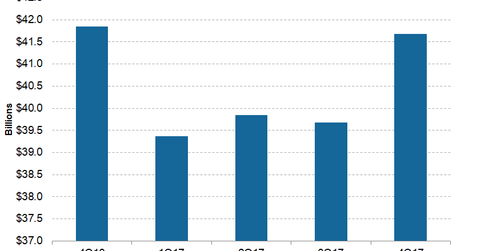What Are AT&T’s Top Priorities for 2018?
AT&T’s management stated that in 2018, the company’s top priority would be closing the Time Warner (TWX) deal.
March 13 2018, Updated 10:30 a.m. ET

AT&T’s top priorities for 2018
AT&T (T), the second-largest wireless service provider in the US, reported mixed 4Q17 financial results with stronger-than-expected revenues and operating metrics, while EBITDA (earnings before interest, tax, depreciation, and amortization) was somewhat below Wall Street analyst consensus estimates.
During AT&T’s recent 4Q17 earnings conference call, AT&T’s management stated that in 2018, the company’s top priority would be closing the Time Warner (TWX) deal. Earlier in October 2016, AT&T signed an agreement to procure Time Warner, where the former agreed to pay $107.50 per share to Time Warner’s shareholders. AT&T also decided to take over Time Warner’s debt, valuing the company at $108.7 billion.
The proposed merger would unite the US’s biggest pay-TV satellite distributor with Time Warner’s media properties, which includes HBO and Turner Broadcasting, the Warner Bros. film studio, cable networks TBS, TNT, and CNN, as well as a 10% stake in Internet video provider Hulu.
The deal with Time Warner would be a win-win situation for both firms, as AT&T would have access to Time Warner’s high-quality content. Likewise, Time Warner would gain from AT&T’s extensive customer base and its distribution network across wireless, video, and fixed broadband platforms.
New revenue streams
The above graph demonstrates AT&T’s total revenue over the past few quarters. AT&T had reported total revenue of $41.7 billion in 4Q17. The proposed merger with Time Warner is expected to unlock new growth opportunities for AT&T beyond its primary phone carrier business, where its growth has slowed in the last several quarters. Smaller competitors such as Sprint (S) and T-Mobile (TMUS) are aiming to attract customers away from other major US wireless service providers such as AT&T and Verizon (VZ) with aggressive pricing techniques. In 4Q17, T-Mobile and Sprint added 891,000 and 184,000 postpaid phone net customers, respectively. During the same quarter, Verizon had added 431,000 postpaid phone net customers, while AT&T gained 329,000 postpaid phone net customers.
